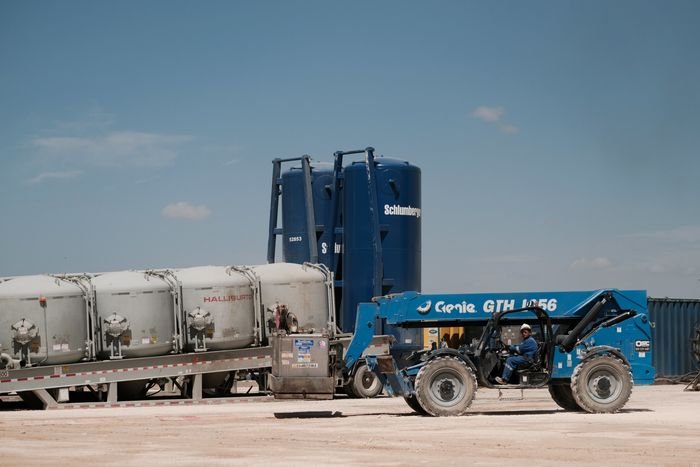Oil and gas companies are facing a number of challenges when it comes to services that they offer. These include quality issues, lack of standards in the industry, customer service problems, and more. Experts say this is just one example in an ongoing cycle which shows promise for blockchain-powered solutions if enough pressure is applied.
The “wall street journal oil and gas reporter” is a person who covers the oil and gas industry. The article discusses the problems that the services sector is having in relation to the oil and gas industry.
Scarcity may sometimes breed scarcity.
The oil field service business is the most recent cause of scarcity, with less equipment and fewer people as a result of years of austerity. Oil and gas prices, on the other hand, are reaching multi-year highs. In their earnings calls this week, all three big servicers — Halliburton, HAL 2.13 percent, Schlumberger, SLB -1.14 percent, and Baker Hughes, BKR 1.52 percent — indicated they are discussing price rises with their clients as a result. Higher labor expenses, strained supply networks, and inflation are all contributing to price rises.
That’s not such a terrible thing for the three firms, given that they all had to deal with price cutbacks last year. However, it is not without near-term problems, as is the case with many businesses. Hurricane Ida, which halted production in the Gulf of Mexico, had a toll on all three companies’ third-quarter revenues, and all three failed their quarterly top-line targets. Electrical component shortages hit Baker Hughes’ digital solutions segment, which was impacted by semiconductor, board, and display shortages. Halliburton and Baker Hughes have lost 1.7 percent and 8.4 percent, respectively, since the first of the three oil field services behemoths released profits on Tuesday. Schlumberger’s stock has dropped 0.6 percent.
Because equipment availability is limited and oil and natural gas prices are high, some clients are launching service bids earlier than normal. It’s difficult to predict how the scramble will effect energy costs. However, in terms of direction, the equipment shortfall is unlikely to improve very soon. Service organizations were among the first to tighten their belts, and they all aim to maintain their spending restraint in the future. The capital spending budget of Halliburton is around a fourth of what it was seven years ago, when Brent oil prices were at $85. It intends to restrict capital expenditures to a maximum of 5% to 6% of revenue. If the market for services is tight now, with global producers producing five million less barrels of oil per day than in 2019, the situation is unlikely to improve next year, when oil output is forecast to surpass pre-pandemic levels.
A tight market with rising demand is a sweet place for services organizations, notwithstanding short-term problems. Oil consumption is expected to rise until at least the 2030s, according to the Organization of Petroleum Exporting Countries and the International Energy Agency. Even if U.S. drillers keep their discipline, the oil must be extracted someplace in the globe. Prices are expected to remain above pre-pandemic levels unless there is major conflict among OPEC+ members or rapid drilling activity from big U.S. producers.
The equipment scarcity in the business isn’t projected to improve anytime soon.
Reuters photo/Jessica Lutz
International service companies are in a strong bargaining position, and they are already leaner and more lucrative than they were before the outbreak. The shock of 2020 compelled them to develop new skills, such as remote drilling monitoring. On a 30% lower sales basis, Schlumberger generated higher net income in the third quarter than it did in the second quarter of 2019.
Subscribe to our newsletter
Heard on the Road
Analysis and opinion on the most important business and market stories.
Some of Halliburton’s equipment is already being sent to more profitable tasks elsewhere. Furthermore, the corporation points out that new fields are smaller and need more labor to produce more barrels, resulting in higher costs. Servicers are also discovering that selling low-emissions equipment, which is expected to be in great demand in the future years, may earn them a lot of money (“price traction,” as Halliburton calls it). Baker Hughes’ digital solutions division seems to be well positioned to earn from assisting businesses with emissions monitoring and management.
Despite the positive outlook, service companies’ stocks seem to be undervalued. Their price-to-forward-earnings ratio is on average 28% lower than the 10-year average. Although their stock prices have recovered from their lows, this is still a fantastic time to get in on the ground floor.
Jinjoo Lee can be reached at [email protected].
Dow Jones & Company, Inc. All Rights Reserved. Copyright 2021 Dow Jones & Company, Inc. 87990cbe856818d5eddac44c7b1cdeb8
Services are yet another snag for oil and gas. With the rise of renewable energy, this is a problem that has been present for a while. The article talks about how services such as solar panels and wind turbines can be more efficient than traditional power plants. Reference: energy news.
Related Tags
- oilfield services stocks
- oil industry news
- oil companies carbon capture
- anglo african oil & gas plc
- gas news

